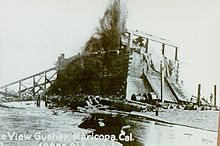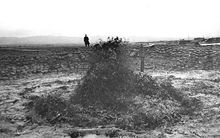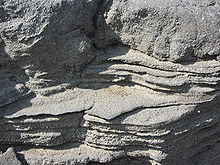Lakeview Gusher
| Lakeview Gusher Number One | |
|---|---|
 The Lakeview gusher with a lake of crude oil surrounding the derrick, mid-1910 | |
 | |
| Location | Kern County, California |
| Coordinates | 35°05′29″N 119°24′05″W / 35.091424°N 119.401377°W |
| Date | 14 March 1910 – September 1911 |
| Cause | |
| Cause | Wellhead blowout |
| Operator | Lakeview Oil Company |
| Spill characteristics | |
| Volume | 9 million barrels (1.4×106 m3) |
| Reference no. | 485 |
Lakeview Gusher Number One was an eruption of hydrocarbons from a pressurized oil well in the Midway-Sunset Oil Field in Kern County, California, in 1910. It created the largest accidental oil spill in history, lasting 18 months and releasing 9 million barrels (1.4×106 m3) of crude oil.[1]
Midway-Sunset was one of the largest oil reserves in the United States. When drilling commenced, the Lakeview Oil Company expected natural gas and a small amount of oil. Instead, there was a large blowout which overloaded storage tanks.[2]
The geyser released more than 1.2 million short tons (1,100,000 t) of crude oil, far more than any other single leak on land or water. Its site is located about a half-mile (800 m) east of the Taft–Maricopa Highway, California Route 33, marked by a Caltrans guide sign and a bronze plaque designated as California Historical Landmark number 485.[3]
Background
The Lakeview Oil Company started drilling at its Number One well on 1 January 1909. Initially only natural gas was found. As work continued the company partnered with the Union Oil Company, which wanted to build storage tanks there.[4]
Early twentieth-century drilling technology lacked such modern safety features as blowout preventers. When drilling reached a well depth of 2,440 ft (740 m) on 15 March 1910,[5] pressurized oil blew through the well casing above the bit. An estimated 9 million barrels (1.4×106 m3) escaped before the gusher was brought under control in September 1911.[6]
The initial daily flow was 18,800 barrels (2,990 m3), creating a river of crude that crews rushed to contain with improvised sand bag dams and dikes. Peak flow reached 90,000 barrels (14,000 m3) per day, diverted via a pipeline to storage tanks 2.5 miles (4.0 km) away, where an 8-inch (200 mm) line led to Port Avila on the coast.[2] In spite of these efforts, less than half of the 9.4 million barrels released during the gusher's 544 days were saved. The rest evaporated or seeped into the ground.[2]
-
River of crude contained by dikes
-
A timber containment box was pulled over the gusher with heavy cables, soon destroyed by the oil's pressure
-
Gusher after the well had partially subsided, the derrick removed, and the well surrounded by a sandbag berm
-
Stratified, congealed crude oil 100 ft (30 m) from the gusher site. The March 2008 image shows an area about 10 in (250 mm) across.
See also
- List of oil spills (in reverse chronological order)
- Largest oil spills in history
References
- ^ Harvey, Steve (13 June 2010). "California's legendary oil spill". Los Angeles Times. Retrieved 14 July 2010.
- ^ a b c "The Lakeview Gusher". San Joaquin Geological Society. 23 September 2002. Archived from the original on 19 October 2006. Retrieved 11 June 2010.
- ^ "Lakeview Gusher". Office of Historic Preservation, California State Parks. Retrieved 2012-10-07.
- ^ Bailey, Richard C. (1967). Kern County Place Names. Bakersfield: Merchant's Printing and Lithography Co. OCLC 158106.
- ^ Rintoul, William (1976). Spudding In: Recollections of Pioneer Days in the California Oil Fields. San Francisco: California Historical Society. pp. 106–113. ISBN 978-0-910312-37-0.
- ^ Rintoul, William; Hodgson, Susan F. (1990). Drilling through time: 75 years with California's Division of Oil and Gas. Sacramento: California Department of Conservation, Division of Oil and Gas. pp. 13–15. ISBN 978-0-9627124-0-1.





